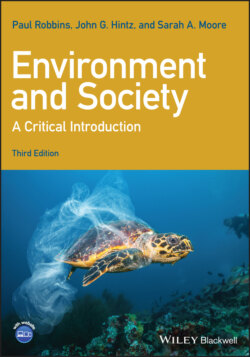Читать книгу Environment and Society - Paul Robbins - Страница 46
Box 3.1 1Environmental Solution? Insurance Addresses Climate Change
ОглавлениеMost global industries have been slow to respond to, or even acknowledge, global climate change. There are good reasons for this. Changing production systems to mitigate climate change by greening the workplace, using alternative energy sources, and creating products with lower climate footprints can be expensive. Acknowledging climate change can cut into the corporate bottom line.
There are some industries, however, where addressing climate change represents an immediate opportunity to avoid lost revenue, or even to make money. The most notable example is insurance, the world’s largest industry, with $4.6 trillion in revenues annually. Insurance is different from other industries since it sells financial products to mitigate risk. Essentially, insurers make the greatest profit when buyers feel a need to protect themselves from risks (like flooding, drought or bad weather), but where these unfortunate events are unlikely to happen. Insurance companies, in other words, need to be able to predict how risky situations are, quantify that risk, and reduce that risk for their buyers wherever possible, so that the insurer collects the most premiums, but pays expensive claims as infrequently as possible.
As such, the insurance industry has a deep interest in understanding, measuring, planning for, and reducing the rate of climate change. This is first because insurers set their rates and calculations based on records from the past, records of decreasing utility in a changing world. If insurers know that a catastrophic flood happens every century, for example, they can calculate how to set rates or whether to insure a high-risk property. But with climate change, the future frequency of these kinds of floods is harder to predict or determine. Insurers need to support good climate science to plan for a changing risk profile. Insurers are also interested in helping their buyers to change their exposure to risk, doing things like protecting their property or using alternative or diverse energy sources, to make them more resilient to changing conditions.
So what is the insurance industry actually doing? First, it is providing new kinds of products to buyers, which favor things like green building practices and decreased energy usage. Insurers worldwide, for example, have introduced 65 different insurance products in the past few years, specifically favoring renewable energy systems. Second, it is paying claims out favorably to buyers who experienced losses (in a major storm, flooding, or drought event) where the buyer rebuilds in a way that is more resilient to future risks, and less likely to suffer losses.
There are, of course, some things that insurance cannot do. Some risks may become so great that insurers will simply no longer cover them. Crop losses in the Midwestern United States, for example, may become so frequent and devastating that insurers may leave that market altogether. So too, insurers have a limited influence on large-scale transformation of national energy systems and transportation networks, which are major drivers of greenhouse gas emissions. Nevertheless, it is clear that thinking about the environment through the lens of financial risk shows that climate change is a major market challenge and an opportunity.
